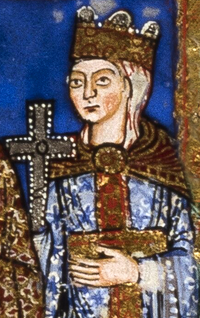
Back Matilda van Engeland Afrikaans ماتيلدا (ملكة إنجلترا) Arabic ماتيلدا ملكة انجلترا ARZ Matilde d'Inglaterra AST امپراتریس ماتیلدا AZB Матильда (Англия Королеваһы) Bashkir Мацільда (каралева Англіі) Byelorussian Мод Bulgarian Matilda Bro-Saoz Breton Carica Matilda BS
| Matilda | |
|---|---|
 Depiction of Matilda in the 12th-century Gospels of Henry the Lion | |
| Tenure | 7 January 1110 – 23 May 1125 |
| Coronation | 25 July 1110 |
| Lady of the English | |
| Reign | 8 April 1141 – 1148[1][2] |
| Predecessor | Stephen (as King of England) |
| Successor | Stephen (as King of England) |
| Contender | Stephen |
| Born | c. 7 February 1102 Possibly Winchester or Sutton Courtenay, England |
| Died | 10 September 1167 (aged 65) Rouen, France |
| Burial |
|
| Spouses | |
| Issue | |
| House | Normandy |
| Father | Henry I of England |
| Mother | Matilda of Scotland |
Empress Matilda (c. 7 February 1102 – 10 September 1167), also known as Empress Maud,[nb 1] was one of the claimants to the English throne during the civil war known as the Anarchy. The daughter and heir of Henry I, king of England and ruler of Normandy, she went to Germany as a child when she was married to the future Holy Roman Emperor Henry V. She travelled with the emperor to Italy in 1116, was controversially crowned empress in St Peter's Basilica, and acted as the imperial regent in Italy. Matilda and Henry V had no children, and when he died in 1125, the imperial crown was claimed by his rival Lothair of Supplinburg.
Matilda's younger and only full brother, William Adelin, died in the White Ship disaster of 1120, leaving Matilda's father and realm facing a potential succession crisis. Upon her widowhood in the Holy Roman Empire, Matilda was recalled to Normandy by her father, who arranged for her to marry Geoffrey of Anjou to form an alliance to protect his southern borders in France. Henry I had no further legitimate children and nominated Matilda as his heir, making his court swear an oath of loyalty to her and her successors, but the decision was not popular in his Anglo-Norman court. Henry died in 1135, but Matilda and Geoffrey faced opposition from the barons. The throne was instead taken by Matilda's male cousin Stephen of Blois, who enjoyed the backing of the English Church. Stephen took steps to solidify his new regime but faced threats both from neighbouring powers and from opponents within his kingdom.
In 1139, Matilda crossed to England to take the kingdom by force, supported by her half-brother Robert, Earl of Gloucester, and her uncle David I of Scotland, while her husband, Geoffrey, focused on conquering Normandy. Matilda's forces captured Stephen at the Battle of Lincoln in 1141, but her attempt to be crowned at Westminster Abbey collapsed in the face of bitter opposition from the London crowds. As a result of this retreat, Matilda was never formally declared Queen of England, and was instead titled "Lady of the English" (Latin: domina Anglorum). Earl Robert was captured following the Rout of Winchester in 1141, and Matilda agreed to exchange him for Stephen. Matilda was besieged at Oxford Castle by Stephen's forces that winter, but escaped at night across the frozen River Isis (Thames) to Abingdon, reputedly wearing white as camouflage in the snow. The war degenerated into a stalemate, with Matilda controlling much of the south-west of England, and Stephen the south-east and the Midlands. Large parts of the rest of the country were in the hands of local, independent barons.
Matilda returned to Normandy, now in the hands of her husband, in 1148, leaving their eldest son to continue the campaign in England; he was eventually declared Stephen's heir after the signing of the Treaty of Wallingford and succeeded to the throne as Henry II in 1154, forming the Angevin Empire. She settled her court near Rouen and for the rest of her life concerned herself with the administration of Normandy, acting on her son's behalf when necessary. Particularly in the early years of her son's reign, she provided political advice and attempted to mediate during the Becket controversy. She worked extensively with the Church, founding Cistercian monasteries, and was known for her piety. She was buried under the high altar at Bec Abbey after her death in 1167, until much later her tomb was moved to Rouen Cathedral.
- ^ David Williamson (1986). Debrett's kings and queens of Britain. Webb & Bower. p. 51. ISBN 9780863501012.
- ^ George Palmer Putnam (1833). Chronology, Or, An Introduction and Index to Universal History, Biography, and Useful Knowledge. D. Appleton & Company. p. 70.
- ^ Hanley 2019, p. 8
Cite error: There are <ref group=nb> tags on this page, but the references will not show without a {{reflist|group=nb}} template (see the help page).